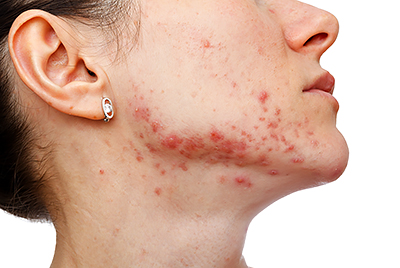Stubborn acne? Hormonal therapy may help

Women who answer yes to any of these questions may want to consider hormonal therapy for acne.
What exactly is hormonal therapy for acne?
Any medication that acts on our hormones is called hormonal therapy. Two hormonal therapies that can effectively clear acne in women are:
Oral contraceptive pills (better known as birth control pills or “the pill”)
Spironolactone (spy-ren-no-lac-tone)
How well does hormonal therapy work, and is it safe?
The pill: Many studies have looked at how well oral contraceptive pills fight acne. The pill has been found effective at treating blackheads, whiteheads, pimples, and acne nodules and cysts.
In fact, the pill has proven so effective that the US Food and Drug Administration (FDA) has approved some oral contraceptives for treating acne.
The pill is generally considered safe for women. Some women, however, should not take it. Your dermatologist can tell you whether the pill may be a safe and effective treatment option for you.
Spironolactone: Doctors prescribe this medication to treat high blood pressure. It’s also prescribed for people who are retaining too much fluid.
Dermatologists have been prescribing it for many years to treat acne and excess hair growth in women. When other acne treatments don’t work, it can effectively treat deep-seated, tender acne on the lower face, jawline, or neck.
Spironolactone is not prescribed to treat acne in men due to side effects. Men have developed breasts while taking this medication to treat acne.
Spironolactone is generally considered safe for healthy women.
Taking both spironolactone and the pill can increase effectiveness. This combination has another advantage. It’s essential to use birth control while taking spironolactone. If you get pregnant while taking spironolactone, your baby can have serious birth defects.
Spironolactone may also be prescribed without the pill. If you’re 35 years of age or older, the pill may not be an option for you and only spironolactone may be prescribed. Taking spironolactone without the pill is also recommended when you have a medical condition that makes it unsafe to take the pill, such as having had a blood clot or stroke.
When taken alone, spironolactone can be quite effective. In looking at the medical records of 85 women who took spironolactone, researchers found that 1/3 of the women had complete clearing and 1/3 had noticeably less acne. Only 7% saw no improvement.
A word of caution
If you can get pregnant, you’ll need to use birth control while taking spironolactone.
Studies have also shown spironolactone to be effective. Improvement ranges from a 50% to 100% reduction in acne.
Before taking spironolactone, it’s important to know that this medication is a diuretic, so you’ll find yourself urinating more often. If this could be a problem, let your dermatologist know.
Spironolactone and potassium
If you take spironolactone, too much potassium can be dangerous. Skip the coconut water and supplements that contain potassium.

What’s involved in taking hormonal therapy for acne?
These medications must be prescribed by a doctor. Each is a pill that you would take daily.
If you’re wondering whether hormonal therapy could help clear your acne, you may want to make an appointment to see a dermatologist. After examining your acne and gathering the necessary information about your health, this doctor can tell you if hormonal therapy may be an option.
Before you see a dermatologist, it helps to prepare for your appointment. You’ll want to be able to tell your dermatologist the following:
Medical conditions you have (or had), including high blood pressure, heart disease, blood clots, migraines, or cancer
Medications you take
Supplements and other natural products you take
Surgeries you’ve had
Medical conditions of close blood relatives, including cancer, kidney disease, or heart disease
If the pill is an option for you, you will have your blood pressure taken to rule out high blood pressure. You don’t need a Pap smear or pelvic exam before a dermatologist can prescribe the pill to treat acne.
Before your dermatologist prescribes spironolactone, you will need some blood tests.
If you begin hormonal therapy, you will need to keep follow-up visits with your dermatologist. Spironolactone requires that you gradually increase the dose, so you’ll need to see your dermatologist every 4 to 6 weeks when you start taking it.
How long does it take to see results?
As with other acne treatments, it takes time to see results. On average, women notice improvement as follows:
The pill: 2 to 3 months
Spironolactone: A decrease in breakouts and oilness in a few weeks
How long do most patients take hormonal treatments?
When hormonal therapy helps to clear acne, a patient may stay on it for a long time. You will often stop other acne treatments such as an antibiotic and medication that you apply to your skin. Hormonal therapy can be used alone to prevent new breakouts.
Taking hormonal therapy long term appears to be safe.
Taking spironolactone?
Studies show that taking spironolactone at the same time every day can give you the best results.

What are the possible side effects?
To reduce the risk of a woman developing serious side effects, dermatologists carefully screen their patients before prescribing hormonal therapy. Possible side effects include the following.
The pill. Taking the pill increases the risk of:
Blood clots
Heart attack
High blood pressure
While these side effects may not seem worth the risk, most women who are healthy do not have side effects. In fact, the risk of developing blood clots is greater during pregnancy and just after having a baby than when taking the pill.
It’s also important to know that there is less risk of serious side effects today than in past. Today, the pill contains less estrogen.
Some women taking the pill develop melasma, or dark patches on their face. Protecting your face from the sun can help prevent these patches.
Breakthrough bleeding is another possible side effect. You can often prevent this by taking the pill at the same time each day.
Acne and the pill
If you take the pill, you can reduce your risk of blood clots by staying active, drinking lots of water, and not smoking.

Spironolactone. When taking spironolactone without a birth control pill, the most common side effects are:
Painful periods and cramping
Irregular periods
Breast tenderness
Breast enlargement
These side effects may be decreased when women also take the pill.
Other possible side effects of taking spironolactone include fatigue, headache, and dizziness. These rarely cause a woman to stop taking the medication.
You may also see a warning about breast cancer in the information that comes with the medication. This warning was included after researchers gave animals very high doses of spironolactone. Some of the animals developed breast cancer.
The possibility that this medication increases a woman’s risk of getting breast cancer is still controversial.
We really don’t have evidence that shows taking spironolactone increases the risk of getting breast cancer. In one study, 1,475 patients prescribed spironolactone were followed for 3 to 7 years. During that time, 9 cases of breast cancer were reported. If none of these patients had taken spironolactone, it is expected that about 8 of them would have developed breast cancer during that time. Other studies have shown similar results.
What helps get the best results?
When taking hormonal therapy for acne, it helps to:
Give the medication time to work
Take the medication at the same time every day
Use everything on your acne treatment plan
Keep all follow-up appointments with your dermatologist
Contact your dermatologist’s office right away if you experience signs of a serious side effect, such as cramping in your leg or arm
Hormonal therapy is an option for many women with stubborn acne, but it’s not always the only option. A dermatologist can tell you what can help clear your stubborn acne.
Images
Getty Images
References
Carol, R. “Hormonal therapies serve as key adjunct acne treatment.” Dermatol World. 2012 May (Acne suppl). 2-6.
Ebede TL, Arch EL, et al. “Hormonal treatment of acne in women.” J Clin Aesthet Dermatol. 2009; 2(12): 16–22.
Harper JC. “Use of oral contraceptives for management of acne vulgaris. Practical considerations in real world practice.” Dermatol Clin. 2016;34(2):159-65.
Kim GK, Del Rosso JQ. “Oral spironolactone in post-teenage female patients with acne vulgaris: Practical considerations for the clinician based on current data and clinical experience.” J Clin Aesthet Dermatol. 2012;5(3):37-50.
Plovanich M; Weng QY, et al. “Low usefulness of potassium monitoring among healthy young women taking spironolactone for acne.” JAMA Dermatol. 2015;151(9):941-4.
Reynolds RVS. "Hormonal treatment for acne.” Presented during the forum: Acne guidelines: Translating evidence into practice. 2017 Annual Meeting of the American Academy of Dermatology; 2017 March 3-7. Orlando, FL.
Zaenglein AL, Pathy AL et al. “Guidelines of care for the management of acne vulgaris.” J Am Acad Dermatol. 2016;74:945-73.
 Atopic dermatitis: More FDA-approved treatments
Atopic dermatitis: More FDA-approved treatments
 Biosimilars: 14 FAQs
Biosimilars: 14 FAQs
 How to trim your nails
How to trim your nails
 Relieve uncontrollably itchy skin
Relieve uncontrollably itchy skin
 Fade dark spots
Fade dark spots
 Untreatable razor bumps or acne?
Untreatable razor bumps or acne?
 Tattoo removal
Tattoo removal
 Scar treatment
Scar treatment
 Free materials to help raise skin cancer awareness
Free materials to help raise skin cancer awareness
 Dermatologist-approved lesson plans, activities you can use
Dermatologist-approved lesson plans, activities you can use
 Find a Dermatologist
Find a Dermatologist
 What is a dermatologist?
What is a dermatologist?